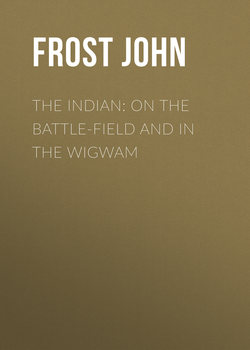Читать книгу The Indian: On the Battle-Field and in the Wigwam - Frost John - Страница 4
THE CAPTIVE SISTER
ОглавлениеNSTANCES are recorded in which white children have been captured and brought up by the Indians, and have so far forgotten early associations as to become identified in habits and manners with their red captors. In most of these cases, the adopted Indian could not be induced to return to the haunts of civilization and the friends of his or her race; which fact would seem to prove that, either the life of the Indian is happier than that of the civilized white man, or, the qualities of our nature may be altered by the power of habit.
In 1778, the family of Mr. Jonathan Slocum, near Wilkesbarre, (Campbell’s Wyoming,) Pennsylvania, was attacked by Indians. Within the house were two girls, aged nine and five years, a son of thirteen, a little boy of two and a half, and their mother. The men were working in the field, and two youths were in the porch grinding a knife. One of the latter was shot and scalped with his own knife. The eldest sister seized the little boy and ran with him towards the fort. The Indians took the boy who had been turning the grindstone, young Slocum, and his sister Frances, and prepared to depart. Little Slocum being lame, they set him down, and proceeded on their way. One of the Indians threw the little girl over his shoulder, and her weeping face was the last object of the mother’s gaze.
About a month afterwards, the savages returned, murdered the aged grandfather, shot a ball into the leg of the lame boy, and then plunging into the woods were heard of no more. Years passed away; the mother died of grief for her lost child. The two remaining brothers, grown to manhood, resolved to ascertain the fate of their sister. They made every inquiry, travelled through the west and into the Canadas, but all in vain; and for fifty-eight years, the captive’s fate was unknown.
At length, in 1836, accident discovered what inquiry could not. The Hon. G. W. Ewing, United States agent to Indian Territory, while travelling on the banks of the Mississiniwa, lost his way and was benighted, and compelled to take shelter in an Indian wigwam. The agent was kindly received, and after supper, entered into conversation with the hostess. He was soon surprised by observing that her hair was fine and flaxen-colored, and that, under her dress, her skin appeared to be white. Upon inquiry, she informed him that she was the daughter of white parents, that her name was Slocum, that when five years old she had been carried captive, by Indians, from a house on the Susquehanna. All else was forgotten.
On reaching home, Ewing wrote an account of the affair, and sent it to Lancaster for publication. Through neglect, however, it was not published for two years afterwards; but it was then seen by Mr. Slocum, of Wilkes-barre, the little boy who had been saved by the girl, sixty years before. He immediately started for Indiana, accompanied by the sister who had saved him, at the same time writing to his brother to meet him at the wigwam. The incidents connected with this visit have been preserved, and are interesting.
On entering the cabin, they beheld an Indian woman, apparently seventy-five years old, painted and jewelled. Yet her hair was as the agent had described it, and her skin beneath her dress appeared white. They obtained an interpreter and began to converse. We may imagine the feelings of the little party, while they listened to the Indian wo-an’s tale. The incidents of the assault and capture – too well known already – were disclosed with a faithfulness which left no room for doubt. “How came your nail gone?” inquired the sister. “My elder brother pounded it off when I was a little child in the shop.”
“What was your name then?” She did not remember. “Was it Frances?” She smiled on hearing the long-forgotten sound, and promptly answered, “Yes.” All were now satisfied that they were of one family, and yet there was little joy in that meeting. There was a sadness, not merely through remembrance of the past, but of a kind present, deep, painful; for though the brothers were walking the cabin unable to speak, and the sister was sobbing, yet there sat the poor Indian sister, no throb of emotion disturbing her equanimity.
Her previous history may soon be told. It was the Delaware tribe who had taken her captive, and when she grew up among them, she married one of their chiefs. He died or deserted her, and she then married a Miami. She had two daughters, who both grew up and married Indians. They all lived in one cabin. The brothers and sisters tried to persuade their sister to return with them, and, if she desired it, to bring her children. She answered that she had always lived with the Indians; that they had always been kind to her; that she had promised her late husband, on his death-bed, never to leave them, and that promise she was resolved to keep. The three generous relatives then retraced their steps, sorrowing that they were compelled to leave their sister in the wilderness.
The Indian sister died in 1847. Her manners and customs were those of the Indians until her death, yet she was admired alike by the red and white men. Her grave is on a beautiful knoll, near the confluence of the Mis-sissiniwa and the Wabash, a spot which had been her residence for nearly thirty years.
